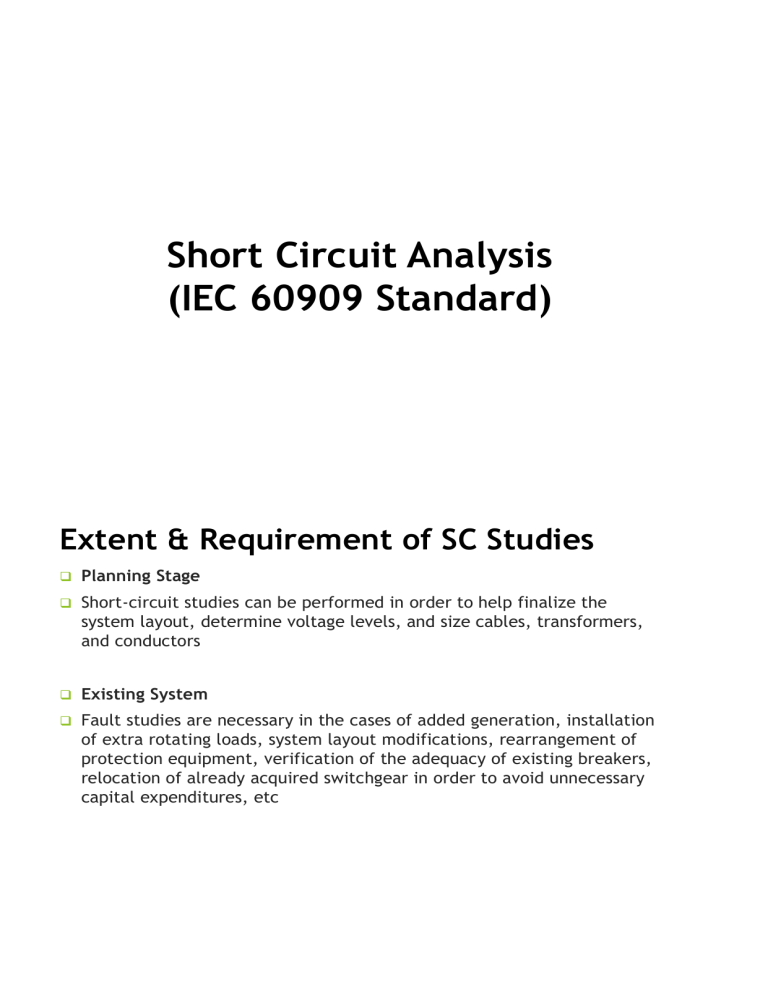
Short Circuit Analysis (IEC 60909 Standard) Extent & Requirement of SC Studies ❑ Planning Stage ❑ Short-circuit studies can be performed in order to help finalize the system layout, determine voltage levels, and size cables, transformers, and conductors ❑ Existing System ❑ Fault studies are necessary in the cases of added generation, installation of extra rotating loads, system layout modifications, rearrangement of protection equipment, verification of the adequacy of existing breakers, relocation of already acquired switchgear in order to avoid unnecessary capital expenditures, etc Purpose of Short Circuit ❑ Short circuit study can be used to determine the following conditions: ❑ ❑ Evaluate the electrical equipment short circuit withstand ❑ Verify the protective device Making capacity ❑ Verify the protective device Breaking capacity ❑ Verify the protective device Thermal withstand capacity Selecting settings for relay coordination Type of Short Circuit Type of Short Circuit Short Circuit Input Data Short Circuit Input Data Short Circuit Input Data Short Circuit Input Data Short Circuit Input Data IEC-60909 Short Circuit Important Terms Calculation Methods Calculation Methods X/R for Peak Current (ip) Calculation Methods Calculation Methods Calculation Methods Short Circuit Phenomenon Short Circuit Phenomenon Thevenin Equivalent AC Component of Fault Current Near-To-Generator Short Circuit This is a short-circuit condition to which at least one synchronous machine contributes a prospective initial short-circuit current which is more than twice the generator’s rated current, or a short-circuit condition to which synchronous and asynchronous motors contribute more than 5% of the initial symmetrical short-circuit current ( I"k) without motors AC Component of Fault Current AC Component of Fault Current Far-From-Generator Short Circuit This is a short-circuit condition during which the magnitude of the symmetrical ac component of available short-circuit current remains essentially constant. AC Component of Fault Current DC Component of Fault Current ❑ The DC component or shift in zero axis of current from reference or true zero (voltage zero axis) results from the necessity to satisfy two conflicting requirements (A) Fault current wave must be maximum (-ve peak) when voltage wave is zero, because of highly inductive source fault impedance (X/R very high) 90 deg. lag of current. (B) The actual instantaneous fault current at fault is the value determined by the pre-fault network condition. It will be zero if fault occurs on unloaded circuit. So instantaneous fault current at t=0 should be zero. DC Component of Fault Current ❑ Fault at zero point on the voltage wave ❑ To satisfy (a) and (b) above the AC current wave will have to be shifted by Ip = √2. Iacsymrms, when fault occurs at zero point of the voltage wave. The shifted current axis is DC component of fault. DC Component of Fault Current ❑ Fault at peak point on the voltage wave ❑ For fault occurring at peak point of voltage wave fault current is already zero (as required from (a) and (b) above) & Hence no current shift is required & Hence no DC component in fault current Decay of DC Component Decay of DC Component IEC Short Circuit Study Case Maximum Short Circuit Currents ❑ Voltage factor Cmax according to Table-1 (IEC 60909) shall be applied for the calculation of maximum short-circuit currents ❑ Choose the system configuration and the maximum contribution from power plants and network feeders which lead to the maximum value of short-circuit current at the short-circuit location ❑ Motors contribution to the fault shall be included ❑ Resistance RL of overhead lines and cables are to be introduced at a temperature of 20 °C Minimum Short Circuit Currents ❑ Voltage factor Cmin according to Table-1 (IEC 60909) shall be applied for the calculation of minimum short-circuit currents ❑ Choose the system configuration and the minimum contribution from power plants and network feeders which lead to the minimum value of short-circuit current at the short-circuit location ❑ Motors contribution to the fault shall be neglected ❑ Resistance RL of overhead lines and cables are to be introduced at a higher temperature Voltage Factor (c) MV CB Short Circuit Duty LV CB Short Circuit Duty MV CB – IEC 62271 CB Test Model Selection of Switchgear / CB Rating Circuit breaker or switchgear should be selected to satisfy “MAKE‟, “BREAK‟ & “THERMAL‟ short circuit duty. ❑ MAKE (kAp) = Peak making duty (at ½ cycle) This is maximum instantaneous fault current magnitude seen by CB/ switchgear during fault. ❑ BREAK (kArms) = Asymmetrical break current in kArms at instant of break of a CB (opening time of CB + relay opening time). ❑ THERMAL = 1 or 3 sec short circuit duty Device Duty Comparison






